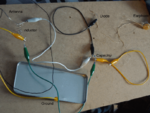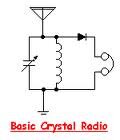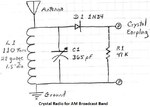Resistanceisfutile
Member level 4
Hi how you doing!
I've been trying to build a crystal radio based on designs I found on the internet.
I built the crystal radio circuit that I found on the internet, but I've had no luck getting it to work. I've attached a photo of the circuit diagram and the circuit I've built (apologies, it is very flimsy).
My components are: a 0.001 uF capacitor and an inductor I calculated to be about 0.16 uH (these form the tuning circuit I'm guessing), a crystal earpiece from an old crystal radio set (so I'm guessing they are the right impedance) and an 0A90 (10mA signal diode). My antenna is simply a wire and my ground is just a lead to a metal lid.
Based on my resonant frequency calculations, the circuit should be tuned to 12.5 MHz and I've been told that if my crystal earpiece is working I'll get static (so even if it is an empty station, I should be getting static right? Can someone confirm this?)
However, I get nothing out of the earphone. Can anyone tell me what I might be doing wrong and how I could solve it?


I've been trying to build a crystal radio based on designs I found on the internet.
I built the crystal radio circuit that I found on the internet, but I've had no luck getting it to work. I've attached a photo of the circuit diagram and the circuit I've built (apologies, it is very flimsy).
My components are: a 0.001 uF capacitor and an inductor I calculated to be about 0.16 uH (these form the tuning circuit I'm guessing), a crystal earpiece from an old crystal radio set (so I'm guessing they are the right impedance) and an 0A90 (10mA signal diode). My antenna is simply a wire and my ground is just a lead to a metal lid.
Based on my resonant frequency calculations, the circuit should be tuned to 12.5 MHz and I've been told that if my crystal earpiece is working I'll get static (so even if it is an empty station, I should be getting static right? Can someone confirm this?)
However, I get nothing out of the earphone. Can anyone tell me what I might be doing wrong and how I could solve it?


